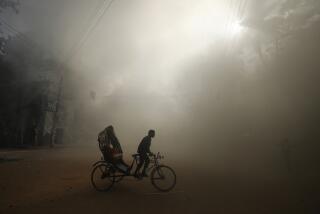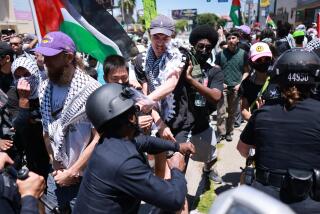Egypt protesters battle police in Cairo streets, Tahrir Square
- Share via
Reporting from Cairo —
Young men wearing surgical masks and hurling stones rushed police barricades Friday against the pop-pop of tear gas rounds that spread white smoke like a gauze over the street as other protesters retreated with the injured draped in their arms.
A new band of men waving flags and splotching their faces with yeast to cut the sting of gas made their run toward the barricades and black-clad riot police in front of the Interior Ministry. Surge and retreat has become a dangerous dance of revolt, full of fury but unable, so far, to break the grip of the nation’s military rulers.
Altogether Thursday and Friday, one demonstrator was killed by birdshot in Cairo and two died in Suez, shot with live ammunition as a mob attempted to storm a police station. The deaths came as cities erupted in clashes after a riot at a soccer game Wednesday that killed 74 people in Port Said. Several independent TV stations reported late Friday that a police station in Cairo was set ablaze and prisoners had escaped.
The soccer riot, which brought accusations of government complicity in the violence, revived the energy of a protest movement that had lost momentum as Egyptians elected a new parliament and turned to pressing economic problems. The country’s military-backed government called for calm, but both it and the ruling generals came under renewed pressure to step down.
Thousands of demonstrators streamed into Cairo’s Tahrir Square while shock troops of young men and boys, some waving the flags of soccer clubs, hustled down side streets and edged closer to the well-fortified Interior Ministry. The pavement was littered with barbed wire, stones and ash fires. The police, who had fired birdshot overnight, waited with tear gas canisters and truncheons.
“We marched toward the Interior Ministry to pray for the martyrs,” said Naser Lotfy, his eyes watering, his nose jammed with tissue. “We kept chanting, ‘peaceful, peaceful,’ so the police wouldn’t beat us, but then we felt the gas and the police striking us. But we’re not leaving.”
Other protesters, entering the square from different parts of the city, called for ending the provocative surges toward the Interior Ministry, a reviled symbol of repression. Some activists reportedly urged young men down from the roof of a government tax office where they had been hurling stones and Molotov cocktails at security forces. State TV reported that protesters set fire to the building.
“If we keep this up more people will die because the tear gas is heavy,” said Khaled Zaki, a lawyer. “The solution is not here, it’s political. We need the interior minister to step down, a reconciliation government and the election of a president.”
Ibrahim Mohammed, an engineer, said, “What good would it do to break into the Interior Ministry? We should go back to Tahrir Square where we belong.”
Ambulances sped nonstop through crowds, ferrying the wounded to makeshift hospitals, including one with a white-coated doctor and blankets and cardboard stretched on the street. Around the corner, in a scene that epitomized Egypt’s differing passions, older men sat at an outdoor a cafe, sipping tea, smoking shisha pipes, indifferent to the thunder of rebellion.
Tarek Ramadan marched past them. A factory worker from Giza, Ramadan carried an Egyptian flag and a Koran, a gas mask and goggles dangling from his neck. He marched toward the barricades like a sentinel from an ancient battlefield.
“I’m here for the rights of our people and to honor the ones who died,” said Ramadan, who blamed the military and police for not preventing the soccer deaths. “If we back down, the military and the police will take over the square. The military is part of the plan by [toppled president] Hosni Mubarak to control the country even after his arrest.”
The military has said it will transfer power to a civilian government after a president is elected in June. It is considering holding the election a month earlier to stem the unrest that has engulfed the capital for months. The new parliament, which is dominated by Islamists, has been cooperating with the army, but the soccer incident has strained the relationship.
While politicians plotted strategies to ease tension, Ahmed Mohamed, a bandage around his head and blood on his jeans, walked past barbed wire and shuttered storefronts.
“I was running,” said the 15-year-old, one of nearly 700 wounded, including about 150 police officers. “Tear gas was fired and the police grabbed me from behind. They beat me with sticks. I have four stitches.”
He turned away. Around the corner, tear gas volleys popped and thin clouds of stinging white filled the air as young men gagged, flags in retreat. Ambulances screeched, unconscious protesters were held up on the backs of motorcycles; others doused their faces with water. One man held his hands up as if to stop the crowd.
“Don’t run,” he said as police pushed the crowd farther from the ministry. “Stay here.”
Special correspondent Asmaa Al Zohairy contributed to this report.
More to Read
Sign up for Essential California
The most important California stories and recommendations in your inbox every morning.
You may occasionally receive promotional content from the Los Angeles Times.














